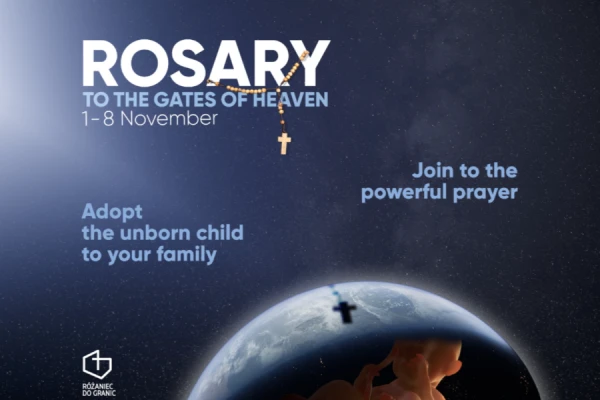
CNA Staff, Nov 2, 2020 / 03:30 am (CNA).- Polish pro-lifers are inviting Catholics around the world to join a global rosary initiative that launched on Sunday.
The “Rosary to the Gates of Heaven” event, which takes place Nov. 1-8, hopes to unite thousands of people around the world in prayer for unborn children.
The initiative, known in Polish as “Różaniec Do Granic Nieba,” is the brainchild of the organizers of the 2017 “Rosary to the Borders” event, when more than a million Poles prayed the rosary at the country’s borders. The gathering inspired other countries to hold similar events.
Last year, the organizers brought together tens of thousands of people for a prayer meeting known as “Poland Under the Cross.”
The rosary initiative comes amid widespread protests in Poland following a landmark court ruling on abortion.
Protesters disrupted Masses across the country after the constitutional court ruled Oct. 22 that a law permitting abortion for fetal abnormalities was unconstitutional. The ruling, which cannot be appealed, could lead to a significant reduction in the number of abortions in the country.
Videos on social media showed protesters interrupting Sunday Masses while holding signs supporting abortion. They also left graffiti on church property, vandalized a statue of St. John Paul II, and chanted slogans at clergy, as well as blocking roads and bridges.
In response to the protests, Polish President Andrzej Duda said Oct. 30 that he would propose a bill permitting abortion in cases of fatal fetal abnormality.
Abortion will continue to remain legal in cases of rape, incest, and risk to the mother’s life.
The “Rosary to the Gates of Heaven” began on All Saints’ Day. Organizers said that Catholics could join the initiative on any day by reciting a series of prayers, including the rosary, at a cemetery, roadside cross, or parish, or at home.
On the initiative’s website, the organizers wrote: “The consequences of killing the unborn children become more and more visible and affect us more and more.”
“By this atonement prayer we want to make reparation to God for the sin of abortion and reward the suffering of unborn children. We want to save Poland and the world from the consequences of this sin.”
If you value the news and views Catholic World Report provides, please consider donating to support our efforts. Your contribution will help us continue to make CWR available to all readers worldwide for free, without a subscription. Thank you for your generosity!
Click here for more information on donating to CWR. Click here to sign up for our newsletter.



Leave a Reply